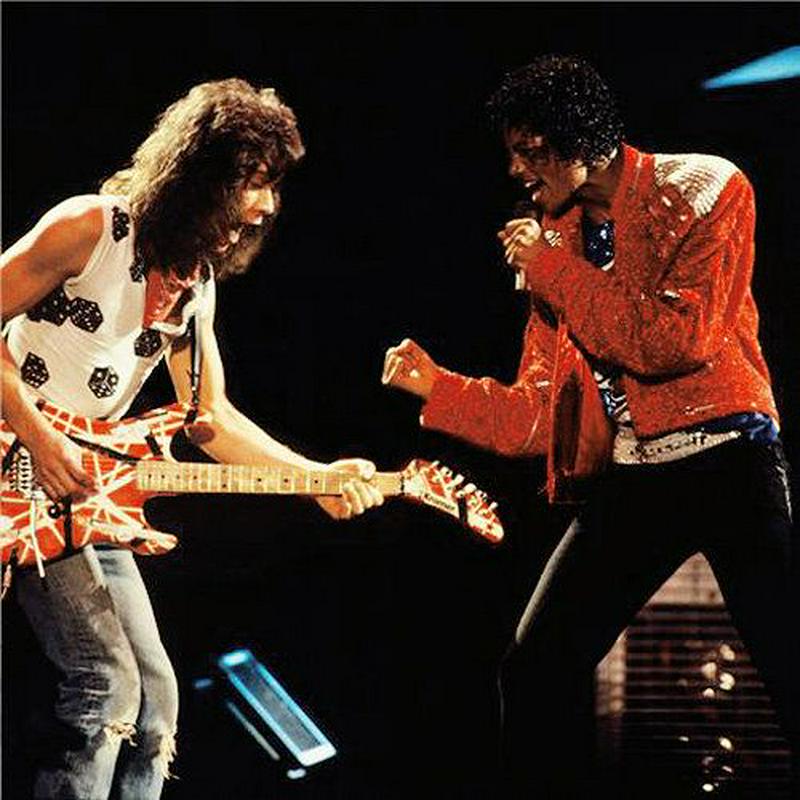How Van Halen Changed Michael Jackson's Beat It And Music History
By | January 14, 2022

“Beat It,” improbably, blended the genius of Eddie Van Halen and Michael Jackson to ignite the King of Pop’s most iconic album. Prior to Thriller’s 1982 November release, MJ had not yet assumed the mantle. Yes, Jackson already owned Grammys, American Music Awards, and secured the highest royalty rate in the industry at 37%.
However, the monumental crossover success of his “Thriller” album, highlighted by “Beat It” took Jackson to heights previously unknown. It sold the world over and then some while also receiving credit for taking hard rock mainstream. Perhaps most incredibly, Van Halen only earned a pair of six-packs for his cataclysmic inducing input. As they say, “it doesn't matter who's wrong or right. Just beat it.”

A Phone Call For The Ages
Typically, when a musician accumulates the level of success of someone like Van Halen, they don’t dole out their genius willy-nilly. So when Quincy Jones called and asked if Eddie would lay some chords for Michael Jackson, he actually thought it was a prank call. Undoubtedly, if the other members of Van Halen were in Los Angeles at the time, he never would have ended up on “Beat It.”
As Eddie recalled, "Everybody (from Van Halen) was out of town and I figured, 'Who's gonna know if I play on this kid's record?' I did it as a favor. I was a complete fool, according to the rest of the band, our manager and everyone else. I was not used. I knew what I was doing. It was 20 minutes of my life. I didn’t want anything for doing that... I literally thought to myself, ‘Who is possibly going to know if I play on this kid’s record?’

Historical Tweaks
Upon arriving in the studio, Van Halen naturally had some ideas of his own. Jones knew to let the chef cook, "I said, 'I'm not going to tell you what to play, the reason you're here is because of what you do play…' So that's what he did. He played his ass off."
As Eddie remembered, "So I went to the studio and listened to the song twice, and I didn’t like the section they wanted me to solo over. They wanted me to solo over the breakdown. I asked Quincy Jones to edit the chords underneath the solo. Then I could play the solo in the key of E, but it was the chords underneath that made the solo interesting. So I guess I did rearrange it.”

Force Multiply Genius
Of course, experimenting with another artists’ work can be like trying to teach their kids; they may not agree with your lessons. Van Halen was very cognizant of that fact, “Artists are kind of crazy people. We're all a little bit strange. I didn't know how he would react to what I was doing. I said, 'Look, I changed the middle section of your song.' Now in my mind, he's either going to have his bodyguards kick me out for butchering his song, or he's going to like it.”
Inevitably, real recognized real. “And so he gave it a listen, and he turned to me and went, 'Wow, thank you so much for having the passion to not just come in and blaze a solo, but to actually care about the song, and make it better'. He was this musical genius with this childlike innocence. He was such a professional, and such a sweetheart."

A Cultural Shift
Thanks in part to “Beat It,” Michael Jackson became one of the first black musicians to regularly get air time on MTV. The massive hit not only introduced hard rock to the masses but also Michael Jackson to suburban white kids. According to Rod Temperton, who wrote the title track to Thriller, the song was literally fire from day one. “Eddie was playing and the monitor speakers literally caught on fire and we’re all thinking, like, 'This must be really good.’”
Van Halen vividly experienced the reach of “Beat It.” "I'll never forget when Tower Records was still open over here in Sherman Oaks. I was buying something, and 'Beat It' was playing over the store sound system. The solo comes on, and I hear these kids in front of me going, 'Listen to this guy trying to sound like Eddie Van Halen'. "I tapped him on the shoulder and said, 'That IS me!' That was hilarious."
